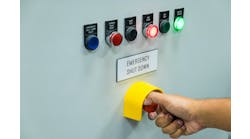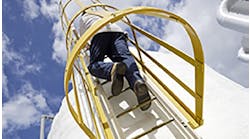Nearly two years have gone by since the devastating events of September 11, 2001. Prior to that day ," before terrorists on a suicide mission transformed four commercial jetliners into instruments of destruction ," terrorist weapons of choice generally were limited to guns, bombs and the like.
The events of that fateful day forever changed America, however.
Suddenly, our food and water supplies seemed vulnerable. The most harmless of white powders had the ability to put us on edge. And long-standing apprehensions related to access to chemical-site "worst-case-scenario" information seemed newly justified.*
Could terrorists really turn a chemical facility into a weapon of mass destruction?
The chilling reality is that they could.
In fact, the U.S. Environmental Protection Agency (EPA) reported that 123 of the chemical plants across the United States each contain enough toxic chemicals to potentially kill or injure more than a million people if a release were to occur. Another 750 facilities loom as threats to more than 100,000 people apiece.
According to the U.S. General Accounting Office (GAO), "chemical facilities may be attractive targets for terrorists intent on causing economic harm and loss of life."
Falling through the cracks
Following the events of September 11, the American Chemistry Council (ACC), the Chlorine Institute and the Synthetic Organic Chemical Manufacturers Association (SOCMA) quickly took action, publishing "Site Security Guidelines for the U.S. Chemical Industry" in October 2001. ACC and SOCMA soon followed up with their new Responsible Care Security Code, to which chemical facilities must adhere as a condition of membership.
Kudos to ACC, SOCMA and other industry associations that have taken a leadership role on chemical site security. Such voluntary actions have drastically reduced the risks at many facilities.
However, overall chemical site security cannot be limited to voluntary efforts led by industry organizations. The fact remains that many chemical and petrochemical entities are not members of these industry organizations. Moreover, the voluntary security measures required under the new code call for third-party verification, but no one agency has been charged with monitoring or documenting the extent to which these facilities have implemented security measures.
Although GAO says EPA "believes" the Clean Air Act could be interpreted as providing the authority to require chemical facilities to assess their vulnerabilities and make security enhancements that protect against attacks, the agency has not attempted to use these provisions.
Why? According to GAO, EPA is concerned the interpretation would pose a significant litigation risk and has concluded that chemical facility security would be addressed more effectively by the passage of specific legislation.
I agree ," partially because I do not believe that an agency specializing in environment matters qualifies as a security expert, and partially because a disaster could result if just one facility slipped through the security cracks.
Don't get me wrong. I trust that most of our nation's chemical and petrochemical facilities will do the right thing ," make the necessary changes to boost facility security. However, I cannot say that I trust all of them to do so. And even one bad apple is too many when so many lives are on the line.
Time for action
Sen. Jon Corzine (D-N.J.) introduced the Chemical Security Act in October 2001 when he served on the Senate Environmental and Public Works Committee. The bill called for EPA to work with the Department of Homeland Security to establish minimum requirements to improve chemical plant security. After extensive negotiations and industry input, he revised the bill. Thus far, however, Corzine has been unsuccessful in taking his legislation to a vote.
Meanwhile, Sen. James Inhofe (R.-Okla.), who now heads the Senate Environmental and Public Works Committee, is said to be putting the finishing touches on another security bill ," one that President Bush reportedly asked him to draft. A spokesperson for the Senate Committee on Environment & Public Works (majority) told me he expects the Bush/Inhofe Bill to be introduced this month. Although the Corzine bill is not "dead," he adds, the committee hopes to incorporate portions of that bill into the new Inhofe bill instead.
I say enough already. The slow reaction on the part of our legislators is threatening the very safety of our nation. While I'm no advocate of overzealous government intervention, I am astute enough to recognize when some sort of official involvement is absolutely necessary. If no speed limits existed, could you trust everybody to drive responsibly?
I urge you to help persuade Congress to "do the right thing." We need responsible chemical plant security legislation that spell outs facility vulnerability assessment requirements and relies on the most appropriate ," and most security savvy ," experts to oversee the security measures ultimately taken.
And we need it yesterday.
*Information provided in facility Offsite Consequence Analysis reports under the EPA's Risk Management Program. Some of this information made its way onto the Internet before widespread concerns resulted in its removal. The information now can be viewed ," but not copied ," in special federal reading rooms nationwide.

